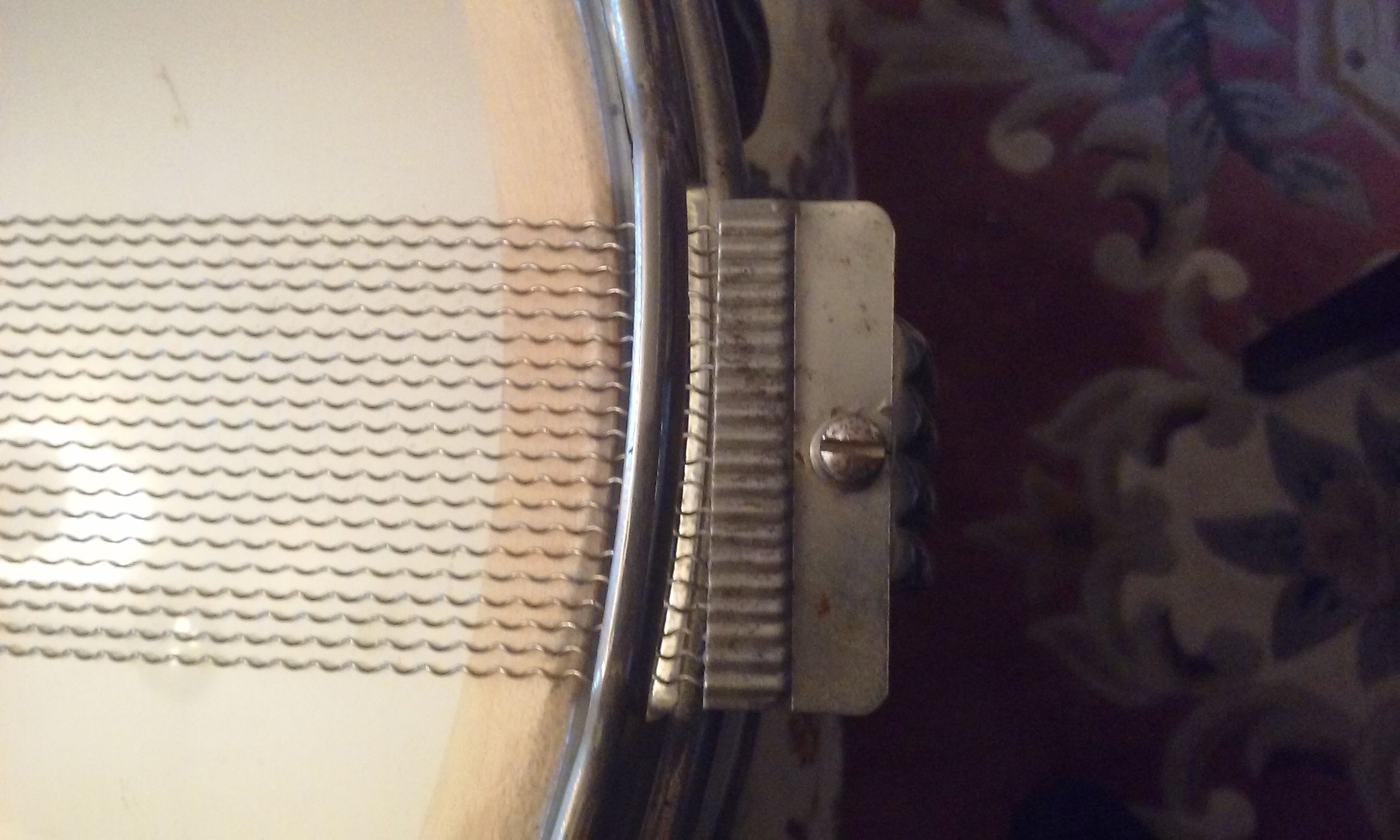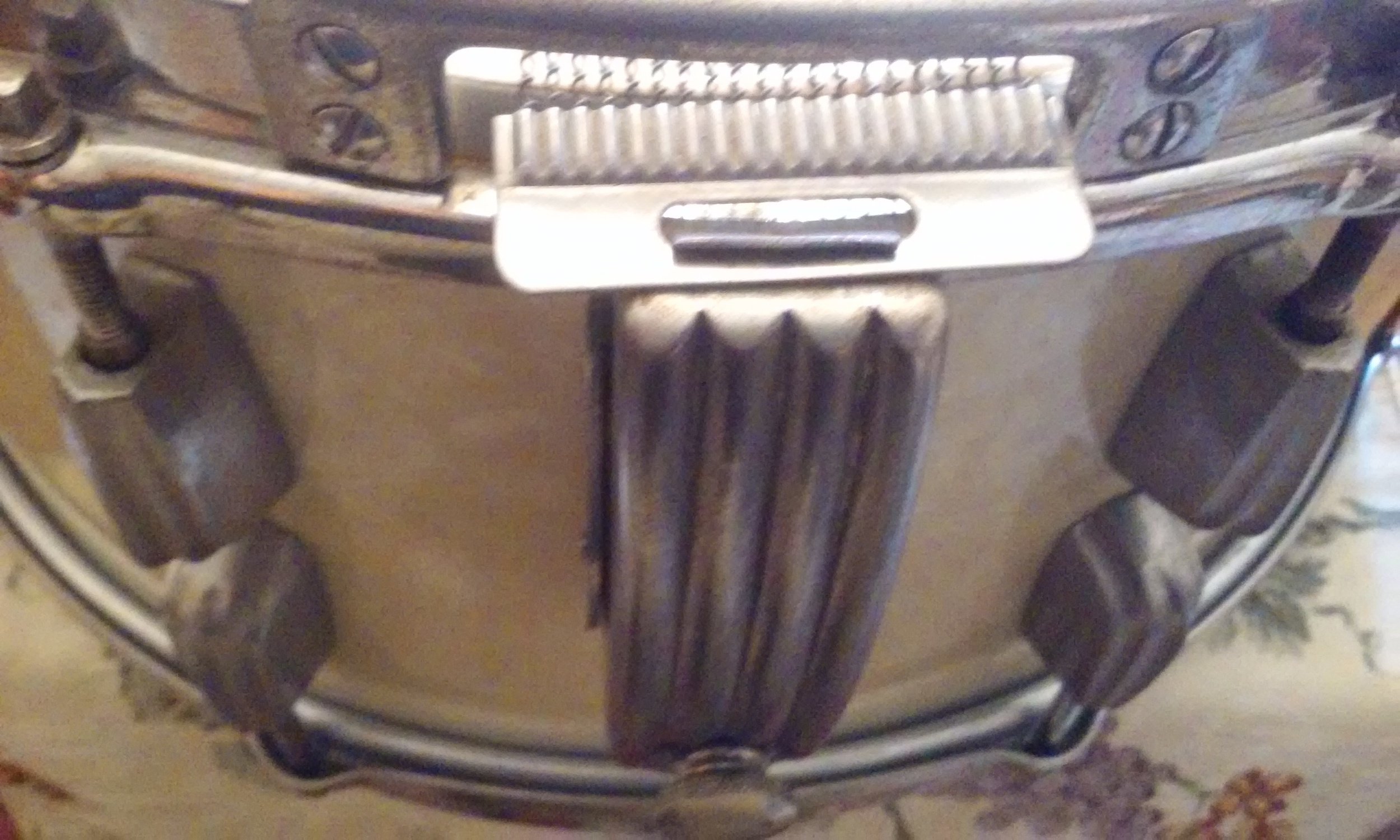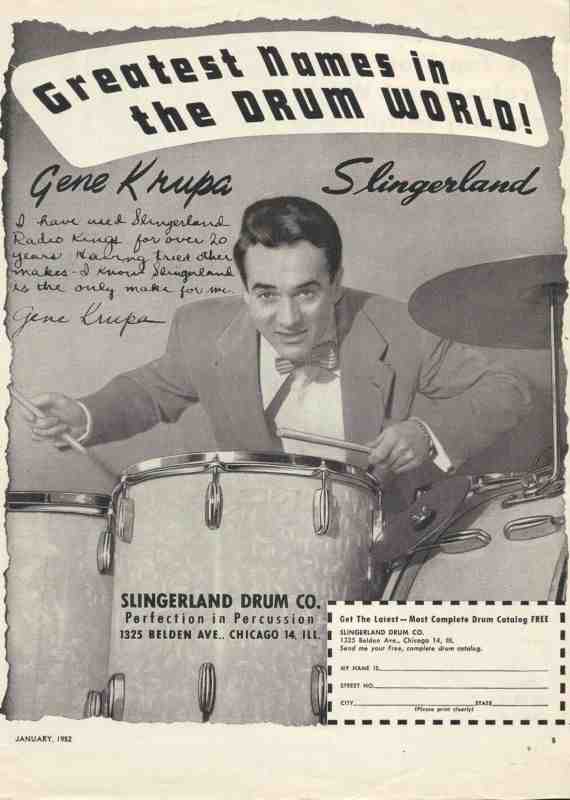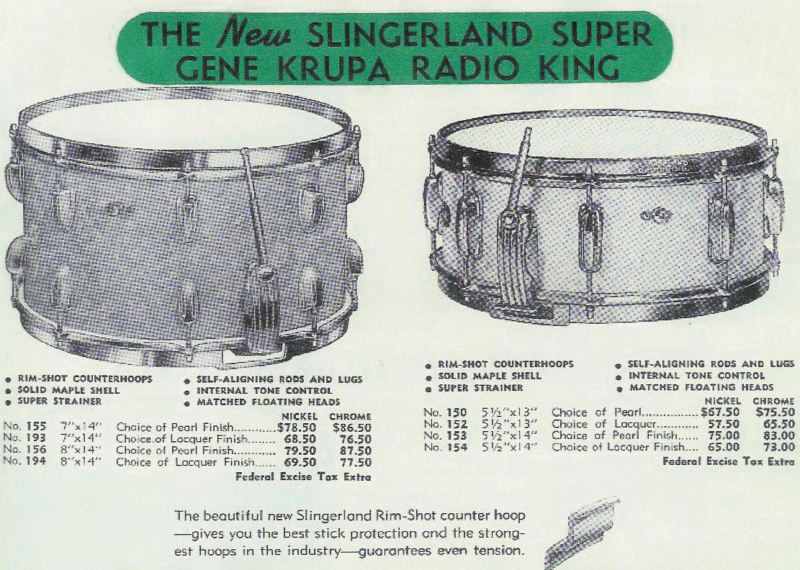In the late 1930s the Slingerland Drum Company had been rocketed into one of the most successful drum companies in the world. "Ace Drummer Man” Gene Krupa had set the jazz scene on fire with his great charismatic, flamboyant & bombastic drumming style. He catapulted the drummer’s role to a whole new level. Drummers came from playing behind the bandstand to become the driving spotlight soloing musicians. Mr. H.H. Slingerland and Mr. Krupa forged an endorser relationship. Krupa was responsible for helping create the Slingerland “Radio King” drum line that was launched in 1936. He would make significant innovative design contributions such as double headed tunable tom toms that would change drumming history. As a result of Gene Krupa's success, Slingerland was inundated with huge orders from the public. Supply was so hard to keep up with that the Slingerland employees were working twenty-four hour shifts. They even started bending green wood planks for their drum shells as there was not enough seasoned wood available.
As a few years passed, Slingerland had reaped the rewards and continued improving upon their products, including the Radio King line. Slingerland decided to go back to the drawing board and create a new Radio King snare drum model. This model would become known as the “New Super Gene Krupa Model” with a unique and innovative strainer system which became known as the "clam shell" strainer. Unlike the Gene Krupa 6.5” x 14” model with the three point strainer and eight center streamline lugs, this new Radio King snare had been drastically redesigned. The Slingerland Company catalogued this Super Strainer system as follows:
• The throw-off side number 976, tension or butt side number 977
• Throw off handle number 976-2
• Tension knob number 977-34.
The strainer design was quite art deco. It resembled a sea-creature’s shell. This 1940 Super Krupa model would also take on a new lug design feature, introduced as the small “beavertail" lug. The Super Gene Krupa Model would now be equipped with sixteen beavertail lugs; eight on top and eight on bottom. This snare shell design was first catalogued and offered in a 7” x 14” size, but was later offered in several sizes and depths. Later catalog sizes were 8” x 14”, 6.5” x 14”, 5.5” x 14”, and 5.5" x 13”.
The shell construction was available in solid maple and three ply mahogany. The main innovative feature would be the Super Krupa strainer design. This interesting design would eventually be modified into four generations of designs spanning two decades, from 1940 to the early 1960s. The shell depth sizes would also change through the spanning years. The very first generation introduced in 1940 had two almost identical machined parts. The throw-off and butt side bottoms of the first series connected the snare wires with metal tongue like extensions that were machined to protrude outward on each side. These tongue extensions passed through each end of the snare wires accommodating an open slot. These rectangular slots were cut out of the ends of the wires on each side. When the Super Throw was engaged left to right with the throw handle, it allowed for refined snare adjustment via a knurled tension knob on the butt side. The throw off side was equipped with a four inch tubular metal handle with an open channel under an interesting tensioning system. This handle came equipped with an optional telescopic extension lever. This enabled the drummer to adjust the height to his exact discretion with the stroke of a drumstick. One could actually throw the handle in either direction to achieve snare wire contact. This handle was attached by a three inch, spring-loaded carriage bolt that ran through the handle and was tensioned inside the shell. The threaded shaft was tightened with two machine nuts and washer with limited adjustment to allow for the handle to throw off left to right. The throw had a channel that accommodated a protruded detente ridge on the inside of the handle. This was the Achilles’ heel as many drummers broke the handle with little effort. The butt side was very close in design to the throw side. However, this side was designed with a threaded shaft that was turned into a female threaded insert. This mechanism was designed to allow for increased or decreased tensioning and fine adjustment of the snare wires. It was very similar to a “parallel” snare mechanism, with wires traveling clear across the snare bed and past the shell. The first snare wires that were introduced for this model were twenty strand, sixteen inch models. These extended wires contributed to the wonderful sensitivity and dynamics of the Super Krupa Radio King sound.
The second generation of the Super Krupa strainer system had undergone a significant change. This version would take on a beautiful and unexpected artistic design.
But on December 7th, 1941 the United States would enter into WWII after the Japanese bombed Pearl Harbor. The government would later implement a ten per cent metal restriction in all non war-essential manufacturing. This would greatly affect production designs of all percussion and musical instruments. As a result, in 1942 the Slingerland Company created and introduced the new “Rolling Bomber” drum line. The Rolling Bomber snare drum would only be available with the Super Krupa Strainer. Unlike the original generation, this drum was equipped with all wooden, hand carved, rose wood or walnut lugs and strainer system. Each side of the strainer would appear virtually the same. This design resembled the first generation Super Strainers without the streamline design, although the dimensions were almost exact in detail. However, this series had the bottom of both sides of the wooden strainer and butt side directly tapped into with a female thread. Also, there were two small metal pins installed into each side of the strainer and butt side. The snare wires on this version were attached with two machine screws directly screwed into each side. The pins would help align and stabilize each end of the snare wires. The very first examples of the throw off handles were actually made of rosewood. However, these handles proved to be fragile at best and broke. These were replaced by metal handles just like the first generation. All in all, this snare was a beautiful work of art and a wonderful example of vintage drum history. This historic snare drum would go on to become one of the most coveted, collectible and desirable snare drums made from the WWII era.
The third generation was introduced around 1946. This Super Krupa strainer took on a very similar design as the previous wartime Rolling Bomber generation. The bottom of both sides of this metal strainer were directly tapped and threaded to accommodate a new larger machine screw. Similar to the Rolling Bomber snare design, the snare wires were attached on both sides with 5/16” x ½” inch machine screws. This strainer merged both the first and second generation’s likenesses in overall design. The throw-off handle remained identical to the previous generations as well.
Finally, the fourth and final generation of the Super Krupa strainer was introduced around 1956-57. This particular strainer had undertaken some new and interesting design changes. The lugs, first introduced in 1955 on this model, became known as the “sound king” style. Also introduced into the fifties Super Krupa Radio King line was the new Be-Bop model in a 5.5” x 13” model. Previously this model was offered only with the three point strainer. The set up for this strainer system was the same design as the 14” version. However, Slingerland utilized the Super Strainer to accommodate 13” snare wires. The lug design of this era was changed to a more modernistic look and rounded shape. The lugs certainly complimented the Super Strainer design. Just like the third generation, this design would be similar in all aspects except for the bottom base attachments. Slingerland added a new innovative hexagon like part that attached both sides of the snare wires. This hexagon bar attached to each side by metal pins. Each side of the bottom base had two machined holes to attach and accommodate these pins. This upgraded design enabled the snare wires to adjust and pivot left to right. The advantage of this unique design allowed for better adjustment and helped the snare wires align for maximum sensitivity. The snare wires were attached with 3/16”x 1/2” machine screws. These were reduced in size to connect via the hexagon pivot bar. Again, the throw off handle remained exactly the same for this strainer system.
In conclusion, the Super Gene Krupa Model was produced for over two decades. This transforming design was a radical change from the three point Krupa model strainer. Time played a role in new improvements and development. The throw off handle became notorious as the weakest component of this design. Thus many of these models were unfortunately upgraded and altered with a non-original modern throw off and butt plate by the consumers. However, many of these models have stood the test of time with and without their original handles. These Super Krupa models are some of the best sounding Radio Kings that Slingerland ever produced. Some of these models require patience for completing detailed set up and tuning. A significant factor is fine tuning and adjustment from the inside of the drum shell for both sides of the strainer. Many of these vintage models were used by some of the best known artists and drummers of our modern time. In some cases, these models are like a diamond in the rough. Many were taken out of playing commission and tossed aside as broken, unplayable drums. However, in most recent years, vintage drum players and collectors have had a resurgence of interest and faith in this awesome Radio King snare. The throw-off handle is being re-manufactured by Drumatix. This handle is accurately reproduced utilizing spring steel to prevent breakage. It is guaranteed not to break or you will receive a replacement.
The venerable Super Gene Krupa “Clam Shell” model may sometimes be passed over by players and collectors for their shortcomings. Although, with some patience and detail work, it can be everything a player would desire in a vintage snare drum. The next time you are in the market for a Radio King snare drum, don’t be afraid to consider this model. The 6.5" x 14” Slingerland Radio King Krupa models may be the most desirable to players and collectors alike. However, quite a few of the Super Krupa drums sound and play every bit as great. After experimenting and understanding this “Clam Shell” model, you will be pleasantly surprised of its full playing potential. You may only have to invest half of the “clams” or money for this awesome instrument. Certainly, “a whole lot of clams” for your snare drum dollar value, drumming arsenal & treasure chest!



















